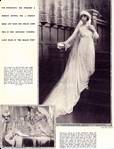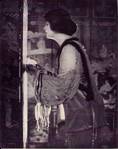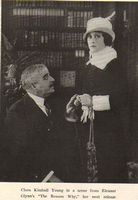

The Reason Why (1918) C.K.Y. Film Corp. Distributor: Select Pictures Corp.; A Select Star Picture. Presenter: Clara Kimball Young. Director: Robert G. Vignola. Assistant Director: William J. Scully. Scenario: Mary Murillo. Camera: Louis J. Physioc. Gowns: Lucile (Lady Duff Gordon). Cast: Clara Kimball Young, Milton Sills, Florence Billings, Frank Losee, John Sunderland, Kate Lester, Eldean Stewart, J.W. Johnston. Young Russian woman neglects to tell her English uncle and the lord he forces her to marry that she is a widow with a child. 5 reels. This film is apparently LOST
| A fashion spread of a Lucile Wedding gown worn in the picture, which appeared in Vogue, July 15, 1918 |  |
| Another Lucile gown from the film, which appeared in Photoplay, October, 1918, photographed by Baron de Meyer |  |
| A sketch of the same tea gown |  |
For more Lucile gowns from this picture, see also Vogue's April 1, 1918 fashion spread
| An unidentfied clipping |  |
Elinor Glyn's "The Reason Why," as a screen play, scenarioized by Mary Murillo, directed by Robert G. Vignola and photographed by Louis J. Physioc, Select has a fine feature with a popular star, and a prominent author's name to play up in the advertising. But, stripped of all accessories, the story is an ordinary one, and has been utilized many times in various forms.
A Russian peasant woman as a brutal drunkard for a husband, and a little son. Husband is killed in a saloon brawl and wife accepts the proffer of a wealthy uncle in London to make her home with him, he not knowing that she had been married. Just why she deemed it necessary to conceal these facts is not quite clear, unless it be that if she didn't there would be no story. At all events, her uncle has plans for her to marry a young lord who is financially indebted to him. He submits the proposition to both, each objecting before they meet.
Meantime the child is being cared for by an elderly lady in a modest household Her uncle compels her to accept the lord and she thinks he is marrying her as a business proposition. As a result they do not assume conjugal relations and he tells her she will beg him on her knees before such a consummation is ever effected. She receives word during a house party that her boy is ill, rushes to him, he follows her and arrives to see the child die. Believing it is an illegitimate offspring, he goes away, she confesses and begs him on bended knees--clinch.
The scenes are rather choppy, jumping from one to another with the same precision as would be employed in the assembling of a piece of machinery. There is never for a moment a doubt as to the outcome, and hence no suspended interest. Just another-and a mild--twist of "The Forge Master" tale, in which the wife finds out she was not married for her money. What redeems it is the production, the value of the star, the excellent support, the adequate direction and good photography.
"THE REASON WHY"
Clara Kimball Young Stars in Select Production of Glyn Novel.
Reviewed by Edward Weitzel.
The hectic flush that gave "Three Weeks" its chief claim to fame is absent from "The Reason Why," an Elinor Glyn story done into photoplay form by Mary Murillo and directed by Robert G. Vignola for Select Pictures with Clara Kimball Young at the head of the cast. Novelty of plot is not one of the story's features, but the troubles of the heroine will appeal to most spectators. Suspense and surprise are also missing. The plot, however, can be followed without the slightest difficulty, and the acting of the entire cast brings out all the points of the story at their best. Director Vignola's care and understanding of his subject have reproduced the English and Russian scenes correctly, the air of wealth and refinement that surrounds Lord Tancred being particularly effective.
Zara, a Russian girl married to a brute of a husband, and the mother of a young son, receives a letter from her uncle in London asking her to come and make her home with him. The uncle does not know that Zara is married. That same night her husband is killed in a brawl and the widow starts at once for England, Arriving there she leaves her boy in charge of a lodging house keeper and goes to her uncle's home. The gentleman has social aspirations and hopes to satisfy them through his niece. Lord Tancred, of an old and impoverished family, is in the uncle's debt. Markrute, the uncle, suggests a union between the nobleman and his niece. Tancred refuses until he meets Zara. He then says he would be glad to make her his wife even if she had no dowry.
Zara is persuaded to accept the nobleman, but after the marriage she keeps him at a distance, as she is convinced money was the only reason for Tancred's wanting the match. On the night of their first reception word is brought to Zara that her son is very ill. She hurries to him. Her husband follows and discovers his wife at the beside of the dying child. He goes back home and does not let her know that he has discovered her secret. The reconciliation occurs when Tancred starts to leave home forever, satisfied that his wife will never love him.
With Clara Kimball Young as Zara, Milton B. Sills as Lord Tancred, Florence K. Billings as Lady Highford, Frank Losee as Markrute, John Sunderland as Lord Ellerton, Kate Lester as the Duchess and Eidean Stewart as Mimo, a fine performance of all the character is guaranteed. Young Master Stewart is a remarkable child actor. Louis J. Physico [sic] did the camera work.
THE REASON WHY
Select Pictures Present Clara Kimball Young in Mary Murillo's Screen Version of Elinor Glyn's Famous Novel of the Same Title; Photographed by Louis J. Physioc, Directed by Robert G. Vignola. Released During April
Cast:
| Zara | Clara Kimball Young |
| Lord Tancred | Milton B. Sills |
| Lady Highford | Florence K. Billings |
| Francis Markrute | Frank Losee |
| Lord Ellerton | John Sunderland |
| Duchess of Glastenbury | Kate Lester |
| Mimo | Eldean Stewart |
The Story: A Russian refugee who masquerades as Zara, niece of Francis Markrute, comes to his home and marries Lord Tancred, a scion of the English nobility. After a long series of misadventures she make a full confession to her supposed uncle and to her husband regarding her origin and her young son by a former marriage to a Russian prefect of police, whom an infuriated mob murdered for his cruelty. Tancred is stunned, but only for a moment. Overwhelmed with forgiveness he avows his undying love.
Feature: Clara Kimball Young as Margaret Case.
Corliss Giles, Pell Trenton, Edward Kimball, and Josie Sadler, all of whom have been starred or featured in other plays.
Program and Advertising Phrases: Famous Story Brought to the Screen by World-Famous Actress.
Clara Kimball Young Ideally Adapted to Her Role.
Perfected Elegance and Artistic Finish.
Will Endure as a Screen Classic.
Clara Kimball Young Outshines her Previous Successes.
Greatest of Screen Favorites in Her Greatest Play.
World-Famous Novel Makes Famous Photoplay.
Elaborate Fashion Show in Lucille-Made Gowns.
The Supreme Law of Womanhood.
The Screen's Greatest Star in Her Best Photoplay.
Wealth and Fashion Reflected on the Screen.
Thrilling Romance of Love and Passion.
The Madonna of the Screen.
A Romance of High Society.
Superby [sic] Acted; Gorgeously Produced.
Stunt Suggestions: The popularity of the book, the vogue of the star and the appeal of elaborate advertising equipment must be depended upon to awaken interest. "Stunts" are inappropriate in many instances and this is one where advertising methods must be dignified to be fully effective. Use liberally of the pictures, printing and press work supplied by the exchange.
Advertising Aids: Two one-sheets, two three-sheets, one six-sheet, one 24-sheet. Window cards, 14x21. Heralds. Lobby display. Photographs, 8x10, 11x14, 22x28. Slides, cut, two one-column, two two column, one three-column, one one-half column cut of star, and one-column and one two-column cuts of star.
Last revised October 14, 2005